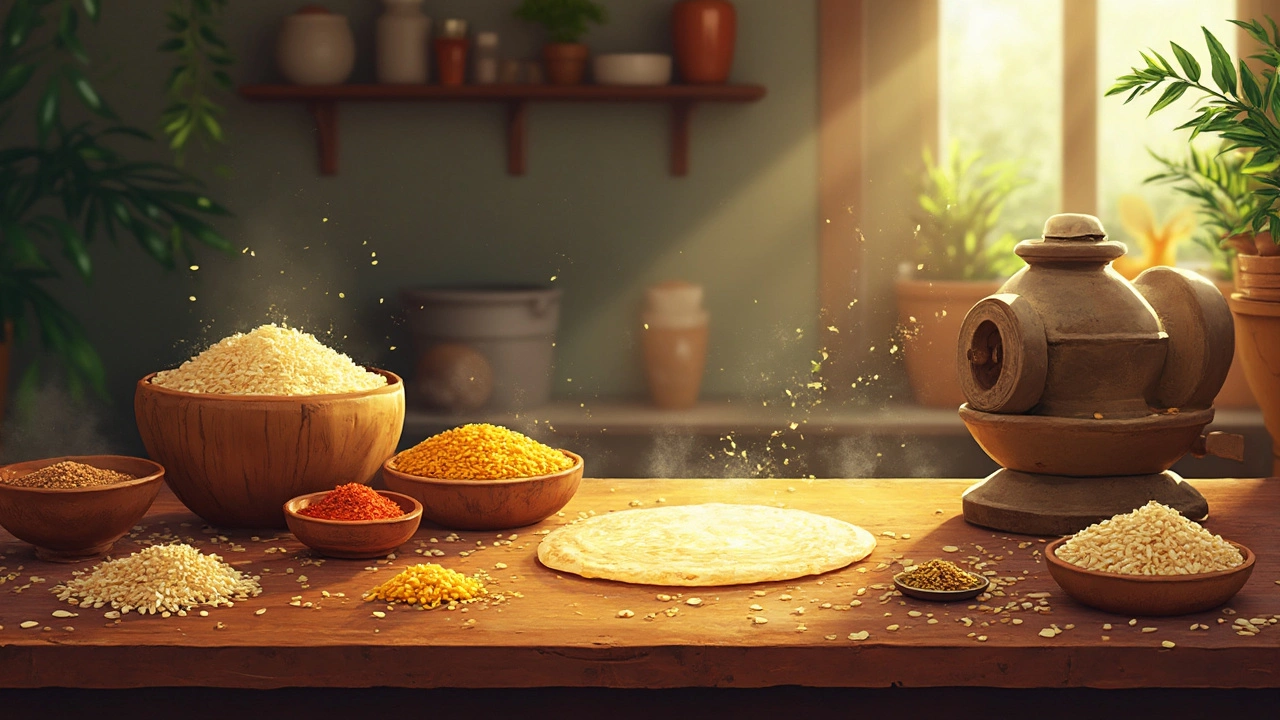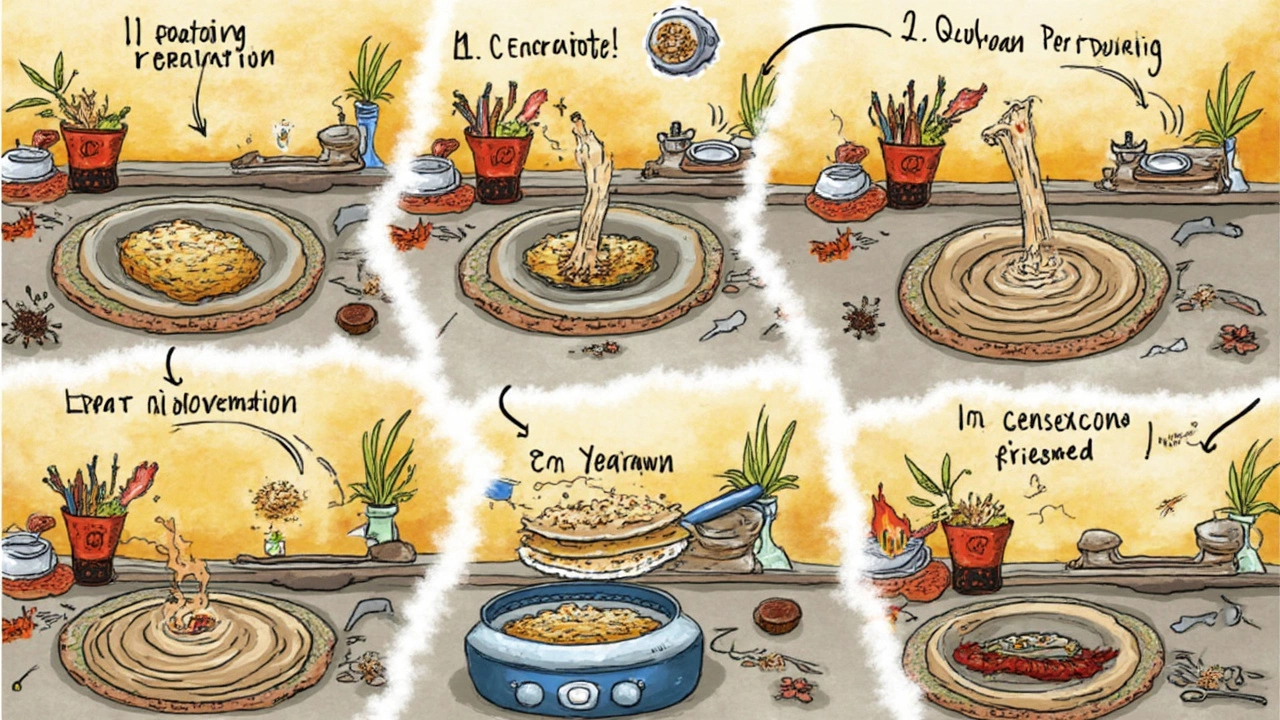Easy Dosa Batter Fermentation Without Yeast: A Beginner’s Guide
 Feb, 12 2025
Feb, 12 2025
When it comes to making dosas, getting the batter right is crucial. You're in luck, because fermenting dosa batter without yeast is as easy as pie—or dosa! You’re just a few steps away from a perfectly fermented batter that'll have you flipping crispy dosas in no time.
First things first: fermentation is simply the process of letting bacteria break down sugars into acids, gases, or alcohol. This is how your batter gets that airy, tangy feel. Luckily, you don’t need any fancy ingredients. Rice and urad dal (a type of lentil) naturally have those bacteria and wild yeasts needed for fermentation. So, put that yeast away and reach for these basic pantry staples.
Now let’s talk soaking. Give your grains time to absorb water overnight, say 6-8 hours. This makes everything softer, which helps in making a smooth batter. Blend it up, add a pinch of patience, and leave the batter to sit for another 8-12 hours in a warm spot. Magic happens here—your humble mixture bubbles and rises, ready to be transformed into delicious dosas.
- Understanding Fermentation
- Choosing the Right Ingredients
- Step-by-Step Fermentation Process
- Troubleshooting Common Problems
- Tips for Perfect Dosas Every Time
Understanding Fermentation
Ever wondered what makes your dosa batter rise without using yeast? Let's break it down. Fermentation is the key player here, and it's been used in cooking for ages. At its core, fermentation is all about letting natural bacteria and wild yeasts present in ingredients like rice and urad dal do their thing. They munch on sugar molecules, turning them into acids and gases.
The Science Behind Fermentation
As the bacteria and yeasts break down the sugars, they produce carbon dioxide. This is the stuff that makes the batter fluffy and airy. The acids produced give that distinct sour taste we love in dosas. Want to boost your fermentation game? Maintain a warm environment for your batter—around 25-30°C (77-86°F) is ideal.
Why No Yeast?
Using commercial yeast is common in baking, but you don't need it for dosa batter. The natural microbes in your ingredients are more than capable of the job. Plus, traditional methods offer better flavors and texture without the additives.
Factors Affecting Fermentation
- Temperature: Keep the batter in a warm place. Cold environments slow down the process.
- Time: Give it time, around 8-12 hours, though this can vary based on your local climate.
- Ingredient Quality: Fresh, good quality rice and urad dal will lead to better fermentation.
So, that's a deep dive into fermenting your batter without yeast. By understanding these essentials, you'll be well on your way to making consistently great dosas.
Choosing the Right Ingredients
Getting the ingredients just right is the backbone of your dosa adventure. With just two main players, rice and urad dal, you might think there's not much to it, but don't let the simplicity fool you. Each plays a vital role in making your dosa batter perfect.
Types of Rice
Let's start with rice. You have options: short-grain rice is a popular pick because it ferments faster and gives a nice texture. Some folks use a mix of short and medium-grain for balance. You don’t want anything super aromatic like basmati here. Aim for anything labeled as 'idli rice' or 'parboiled rice' if you can. Both give your batter a fantastic consistency.
Urad Dal Details
Now for the urad dal. The unsplit, whole, and skinless ones are your go-to. Split urad dal can give you an okay batter, but the whole variety ferments better and lends more fluffiness. Make sure it’s fresh. Older dal can mess with fermentation. As culinary expert Tarla Dalal once said,
"Fresh urad dal is a key ingredient for well-fermented batter. It brings that soft texture and characteristic fluff to your dosas."
Optional Add-ons
While the basics are rice and dal, feel free to experiment a little. Some folks add a handful of poha (flattened rice) for extra softness. If you're feeling adventurous, a teaspoon of fenugreek seeds can also boost fermentation and add flavor.
- Rice: 3 parts, idli rice or parboiled rice preferred
- Urad Dal: 1 part, whole and skinless is best
- Optional: A tablespoon or two of poha, a teaspoon of fenugreek seeds
So there you have it. Getting these ingredients right sets you on the path to making the perfect dosas. It all ties back to keeping things fresh and simple!

Step-by-Step Fermentation Process
Let's get started on the fermentation process, which is simpler than you might think. Follow these steps to get your dosa batter ready without using yeast.
Step 1: Soaking the Ingredients
First, take 2 cups of rice and 1 cup of urad dal. Rinse them thoroughly to remove any impurities or dust. Soak them separately in enough water, as they will expand. Leave them to soak for about 6-8 hours or overnight. This process helps soften the grains, making them easier to blend.
Step 2: Grinding the Batter
Once soaked, drain the water and move on to grinding. Blend the rice first in a blender or a wet grinder, adding water little by little until you get a smooth but thick paste. Transfer this to a large bowl. Follow the same steps with the urad dal, and mix both batters thoroughly.
Step 3: Mixing and Consistency
Now, combine the rice and urad dal batters. Add about a teaspoon of salt—this not only seasons the mixture but also aids in fermentation. Stir the batter well to ensure it's smooth and uniform in consistency. We aim for a pancake-like consistency—thick yet fluid.
Step 4: The Fermentation Magic
Cover the bowl with a lid, but don’t make it airtight. You can even use a clean kitchen cloth. Place the bowl in a warm place, around 25-30 degrees Celsius, for about 8-12 hours. If you live in a cooler region, you might need around 12-15 hours. The fermentation process is indicated by the batter rising and a slight sour aroma.
Here's a quick tip: If your home is too cold, put the covered bowl inside an oven with the light on, or wrap it in a warm blanket. This will help maintain a steady temperature for effective fermentation.
Understanding Fermentation Times
Keep an eye on the environment. Warmer climates will speed up the process, while cooler ones might slow it down. Test the batter’s readiness by lightly touching it—if it's light and fluffy, your dosa batter is set!
| Location | Approximate Fermentation Time |
|---|---|
| Warm Climate | 8-10 hours |
| Moderate Climate | 10-12 hours |
| Cool Climate | 12-15 hours |
And that's it! Your yeast-free, naturally fermented batter is all set to whip up delicious dosas. Happy cooking!
Troubleshooting Common Problems
Okay, so you're all set to make those delectable dosas, but your dosa batter isn't cooperating. Don't worry, we’ve all been there! Let’s take a look at some common mishaps and how you can fix them.
Problem 1: Batter Didn't Rise
If your batter didn't rise, it could be due to a few factors. First, double-check the temperature in your fermentation area. A too-cool environment can slow down the process. Ideally, you want it cozy—think about 77°F to 86°F (25°C to 30°C). Putting it in a switched-off oven with the light on could help bump up the temperature a bit.
Water quality is another sneaky culprit. Chlorinated water can disrupt the natural fermentation process. Try using filtered or boiled and cooled water next time.
Problem 2: Batter Smells Weird
If there's a funky smell, it might mean over-fermentation. Yeah, that's a real thing! Once the batter has risen and turned bubbly, pop it in the fridge to slow down the process. Remember, a tangy aroma is expected, but it shouldn't be off-putting.
Problem 3: Dosas Stick to the Pan
No one wants to be scraping bits off the pan instead of flipping perfect dosas. First, make sure your pan is properly hot. Add a few drops of water—if they sizzle and evaporate quickly, you’re good to go. Also, a well-seasoned cast iron or non-stick pan works wonders.
Helpful Data
Here's a quick rundown of what your batter's life looks like based on temperature:
| Temperature (°F) | Approx. Fermentation Time |
|---|---|
| Below 68°F | 24+ hours |
| 77°F to 86°F | 8-12 hours |
| Above 90°F | 4-6 hours |
Use these insights to adjust your process as needed. Happy dosa making!

Tips for Perfect Dosas Every Time
Nailing that perfect dosa can feel like an art, but once you get a few things down, it becomes second nature. Whether you're a seasoned cook or just getting started, keep these tips in mind to serve up irresistible dosas every time.
Get the Batter Consistency Right
The texture of your dosa batter is key. Think of pouring a thin pancake instead of a thick one—the batter should spread easily in the pan. Too thick? Add a bit of water, but go slow to avoid going too far.
Optimal Fermentation is a Game Changer
A properly fermented batter is your best friend. Give it a whiff—you're looking for a mild sour aroma. Not bubbly and hasn't increased in volume? Your batter might need a warmer spot to ferment. Outdoors in sunlight or near the stove can do the trick.
Use the Right Pan
A good non-stick pan or a seasoned cast-iron tawa makes spreading easier. Sprinkle a bit of water on it—if it sizzles, it's ready. Be sure to dab some oil before spreading your batter for that crispy dosa edge.
The Heat Factor
Temperature control is pivotal. Start with high heat when pouring the batter, then lower the heat as it cooks. It ensures a crispy bottom without burning.
Master the Art of Spreading
Pour your batter in the center and gently spread outward in a spiral motion. Practice makes perfect here, but keep it thin and even for that perfect texture.
| Common Dosa Variations | Additional Ingredients |
|---|---|
| Masala Dosa | Potato filling with spices |
| Onion Dosa | Finely chopped onions and green chili |
It's easy to get disheartened if your first few attempts aren't as you envisioned. But with time and these handy tips, you'll find your rhythm in no time. Remember, even an imperfect dosa is still tasty!